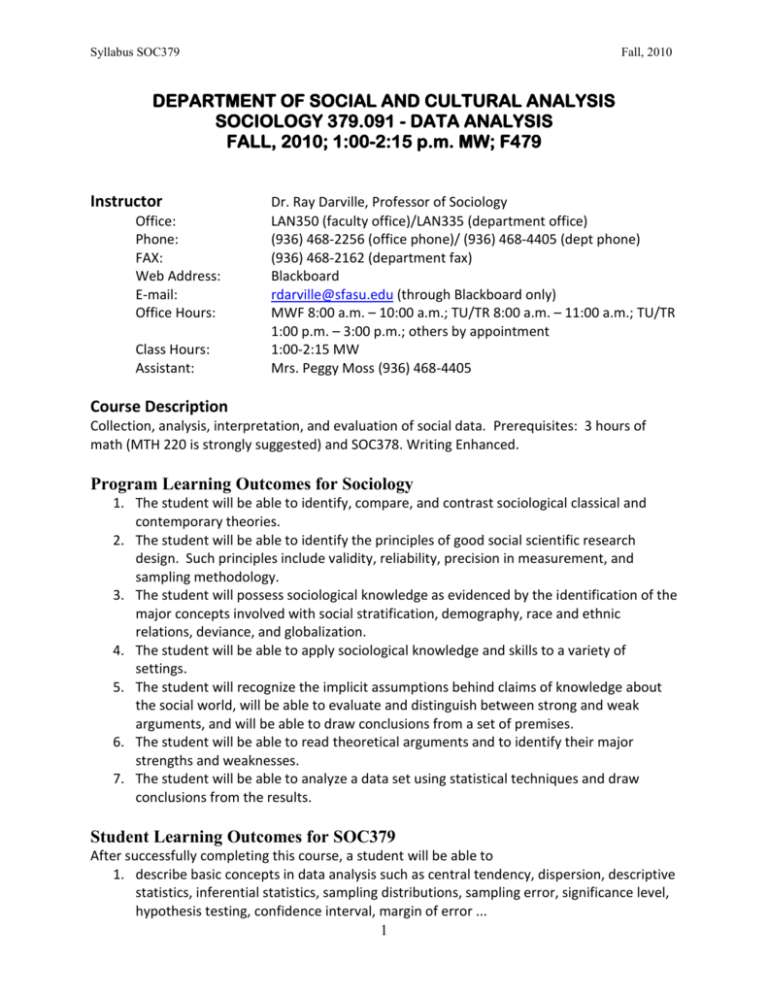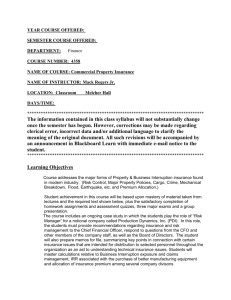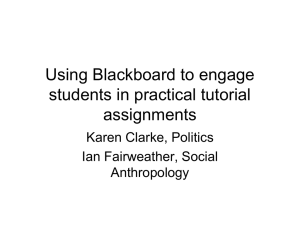department of sociology stephen f - Stephen F. Austin State University
advertisement

Syllabus SOC379 Fall, 2010 DEPARTMENT OF SOCIAL AND CULTURAL ANALYSIS SOCIOLOGY 379.091 - DATA ANALYSIS FALL, 2010; 1:00-2:15 p.m. MW; F479 Instructor Office: Phone: FAX: Web Address: E-mail: Office Hours: Class Hours: Assistant: Dr. Ray Darville, Professor of Sociology LAN350 (faculty office)/LAN335 (department office) (936) 468-2256 (office phone)/ (936) 468-4405 (dept phone) (936) 468-2162 (department fax) Blackboard rdarville@sfasu.edu (through Blackboard only) MWF 8:00 a.m. – 10:00 a.m.; TU/TR 8:00 a.m. – 11:00 a.m.; TU/TR 1:00 p.m. – 3:00 p.m.; others by appointment 1:00-2:15 MW Mrs. Peggy Moss (936) 468-4405 Course Description Collection, analysis, interpretation, and evaluation of social data. Prerequisites: 3 hours of math (MTH 220 is strongly suggested) and SOC378. Writing Enhanced. Program Learning Outcomes for Sociology 1. The student will be able to identify, compare, and contrast sociological classical and contemporary theories. 2. The student will be able to identify the principles of good social scientific research design. Such principles include validity, reliability, precision in measurement, and sampling methodology. 3. The student will possess sociological knowledge as evidenced by the identification of the major concepts involved with social stratification, demography, race and ethnic relations, deviance, and globalization. 4. The student will be able to apply sociological knowledge and skills to a variety of settings. 5. The student will recognize the implicit assumptions behind claims of knowledge about the social world, will be able to evaluate and distinguish between strong and weak arguments, and will be able to draw conclusions from a set of premises. 6. The student will be able to read theoretical arguments and to identify their major strengths and weaknesses. 7. The student will be able to analyze a data set using statistical techniques and draw conclusions from the results. Student Learning Outcomes for SOC379 After successfully completing this course, a student will be able to 1. describe basic concepts in data analysis such as central tendency, dispersion, descriptive statistics, inferential statistics, sampling distributions, sampling error, significance level, hypothesis testing, confidence interval, margin of error ... 1 Syllabus SOC379 Fall, 2010 2. explain what each of the following basic statistics tells you: mode, median, mean, minimum, maximum, range, standard deviation, standard error, ... 3. determine what types of statistical analysis are appropriate for a particular research question and a particular data set 4. use SPSS to conduct statistical analyses 5. take raw data and create an SPSS data set 6. draw appropriate conclusions from statistical analyses 7. present results in written form that are clear, correct, and relevant to the research question 8. correctly complete all the steps in t-statistic, F-ratio, and chi-square hypothesis tests Program Learning Outcome for Sociology PLO1 PLO2 PLO3 PLO4 PLO5 PLO6 PLO7 Supported Student Learning Outcome 1-8 Skill Level Intermediate Text, Software Package, and Calculator Szafran, Bob. 2010. Answering Questions with Statistics (required). To be purchased at local bookstores only. It will come shrink-wrapped and costs about $30. You will probably want to buy a three-ring binder that will hold about 325 sheetss. SPSS 17.0 for Windows Student Version. (optional, but recommended software and manual; ISBN: ). You will be using SPSS throughout the semester (weekly). You may purchase this program for home use and/or use the program at the library computer labs (LINC). The Department maintains the professional version on four computers in the department main office (LAN350). If you need assistance with your assignments, it is a great place for me to assist. Hand-held calculator is strongly recommended. You cannot use your phone calculator. MS PowerPoint or PowerPoint Viewer MS Word or compatible word processing program Adobe Reader Course Requirements Exams, or celebrations. There will be three in-class celebrations (exams), including the final. Each exam will consist of multiple-choice questions and short answer questions. Each celebration is worth a total of 100 points. They will be based on class lecture, class notes, the textbook, assigned readings, and demonstrations. Some of the questions will 2 Syllabus SOC379 Fall, 2010 be basic knowledge questions while others build on that knowledge gained through applied questions. Applied questions require you to understand the material and to be able to think through a problem or to engage in abstract thinking. Much of these questions will involve the written interpretation of statistical output. The written assignments are designed to improve your knowledge and your skills so that you will hopefully perform at a higher level during celebrations. You will need a Scantron 882, a number 2 pencil, and a pen to complete these celebrations. Chapter Reading Quizzes. With almost every chapter that we read and cover in the Szafran book, you will have a chapter reading quiz. These will be taken entirely using Blackboard (the assessment tool). Each quiz will consist of 10 randomly-selected questions from a test bank for each chapter; each test bank will have 30 to 50 questions. Some questions will be multiple choice and some will be true-false. Each question is worth 10 points, and each quiz is worth 100 points. I do not drop any quiz scores. Failure to take the quiz will result in a score of 0 for that quiz. The time limit is 30 minutes to take each quiz. They are open-note and open-book. You may use your lecture notes when taking the quizzes, but the final authority is the textbook. This means that if there is a difference between lecture notes and the textbook, I will use the answer in the textbook for the key. Over the last few years, I have found a moderate, positive relationship between exam scores and quiz scores. This means that students who score well on the quizzes generally do well on the exams; but, keep in mind that this is a pattern and that there are exceptions. While you may see each quiz as relatively unimportant in the overall scheme of the course, quiz scores count for a whole letter grade in the final determination of the course average. Hence, a high quiz average can sometimes, perhaps often, aid a student’s final average, while a low quiz average can hurt a student’s final average. I will post the deadlines on Blackboard for quizzes and give you sufficient time to take the quizzes. The time deadline will always be 11:30 p.m. Chapter Assignments. You will be given chapter assignments from the Szafran book. These are designed to help you better understand the reading material and to practice your data analysis skills. These are VERY IMPORTANT to your work and should not be taken lightly. Each assignment is worth 100 points. Assignments may be submitted late, but will be worth a maximum of 50 points. The due dates will be posted on Blackboard and will be given in class. These must be typed and submitted through Blackboard. More on these in class. Writing Assignments. You will be given writing assignments, which will present you with research situations. You will conduct appropriate data analysis and write results based on your learning during the semester. These assignments will be given in class. Due dates will be included in the assignments. The assignments are part of the writing enhanced aspect of this course. The first assignment will be marked, returned, revised by the student, and resubmitted for final grading. These must be typed and submitted through Blackboard. Blackboard. You are required to use Blackboard in this class. It is a web-enhanced class. If you are not familiar with Blackboard or wish to familiarize yourself with the program, please complete the online orientation program designed by the OIT staff: http://www.oit.sfasu.edu/Blackboard/Access_Orient.htm. If you experience problems 3 Syllabus SOC379 Fall, 2010 with the operation or function of Blackboard, please contact OIT Student Support. Andra Floyd in that office is a good contact person. The phone number is 936-468-1919. Among the features of Blackboard that we will be using are: Calendar, Announcements, Assessments, Gradebook, and others. I would like to remind you that Blackboard records each and every visit you make to the course, what course materials you looked at, what you downloaded, what email you read, when you took your quizzes, and other information. I check this information occasionally to monitor students work in the class. Another important element of Blackboard is the class lecture notes. I will give you partial lecture notes in MS PowerPoint format. Each set of notes contains 20 to 40 slides. I recommend that you print these lecture notes and bring them to class. Furthermore, I recommend that you print 2 or 3 slides per page in order for you to have room to write notes. You will be held responsible on exams for my notes and for what I say in class. Class Attendance I expect excellent class attendance. I will check and record class attendance almost every day. While attendance is not a formal part of your grade determination, I see attendance as a measure of your commitment to this class and most especially your commitment to your own learning. While I will not deduct points for poor attendance, at the same time, do not expect any favorable treatment in the final grade assignment should you have poor class attendance. I try to reward those students who come to class, instead of punishing those who do not. Why do I care about your attendance? First, I care about you and your education. This experience and opportunity may not come again. Make the most of your opportunity now. Second, I care about the why that you will represent SFA as a professional. You are an ambassador (or rather will be) for SFA. Employers and others evaluate SFA based not so much on the buildings, but on the people. Third, the taxpayers of the state subsidize the cost of your education. By not attending, you are cheating them. Fourth, by not attending, you will be cheating yourself and missing an educational experience. Acceptable Student Behavior Classroom behavior should not interfere with the instructor’s ability to conduct the class or the ability of other students to learn from the instructional program (see the Student Conduct Code, policy D-34.1). Unacceptable or disruptive behavior will not be tolerated. Students who disrupt the learning environment may be asked to leave class and may be subject to judicial, academic or other penalties. This prohibition applies to all instructional forums, including electronic, classroom, labs, discussion groups, field trips, etc. The instructor shall have full discretion over what behavior is appropriate/inappropriate in the classroom. Students who do not attend class regularly or who perform poorly on class projects/exams may be referred to the Early Alert Program. This program provides students with recommendations for resources or other assistance that is available to help SFA students succeed. 4 Syllabus SOC379 Fall, 2010 Evaluation Grading Formula 1. Exams 2. Chapter Quizzes 3. Written Assignments Grading Scheme 90% - 100% 80% - 89% 70% - 79% 60% - 69% 00% - 59% = = = = = A B C D F 60% 10% 30% 100% “excellent” “good” “average” “poor” “failing” Notes on Grades I will post your scores on Blackboard only. I do not post final letter grades on Blackboard, but enter them directly into the university computer that handles grades. I will post final class averages on Blackboard. One common understanding among students is that grades are based entirely on student effort, or the amount of time a student spends working on the course material, preparing for exams, etc. While the amount of time devoted to a course affects grades, we also know that some students who work hard receive poorer grades while some students can spend relatively little time on a course and earn excellent grades. In this course, you must work according to your abilities and skills. Grades, at the end of the course, are given for performance, not effort. This happens to mirror the so-called real world in terms of income—some people work really hard for little pay while others can put in relatively less effort and get huge rewards. You may work just as hard as physicians, for example, but will probably not have the earning power that they have. Another issue is the grade distribution. The SFA General Bulletin discusses the grade definition above such that an A grade is reserved for excellent performance, a B grade is assigned for good performance, a C is assigned as average performance, a D for poor performance, and a F grade for failing performance. This conceptualization suggests that many of you (perhaps 40% to 50%) will earn a grade of C. A “C” grade is not a “bad” grade. It suggests that performance is satisfactory, but not exceptional. Social work majors need a grade of C or higher, of course, because of social work program rules. My job is to help you succeed in this class, to provide a suitable learning environment, to answer your questions; I am making that commitment to you. I hope that your commitment to this course and your success is appropriate. 5 Syllabus SOC379 Fall, 2010 Academic Integrity (A-9.1) Academic integrity is a responsibility of all university faculty and students. Faculty members promote academic integrity in multiple ways including instruction on the components of academic honesty, as well as abiding by university policy on penalties for cheating and plagiarism. Definition of Academic Dishonesty Academic dishonesty includes both cheating and plagiarism. Cheating includes but is not limited to (1) using or attempting to use unauthorized materials to aid in achieving a better grade on a component of a class; (2) the falsification or invention of any information, including citations, on an assigned exercise; and/or (3) helping or attempting to help another in an act of cheating or plagiarism. Plagiarism is presenting the words or ideas of another person as if they were your own. Examples of plagiarism are (1) submitting an assignment as if it were one's own work when, in fact, it is at least partly the work of another; (2) submitting a work that has been purchased or otherwise obtained from an Internet source or another source; and (3) incorporating the words or ideas of an author into one's paper without giving the author due credit. Please read the complete policy at: http://www.sfasu.edu/policies/academic_integrity.asp Withheld Grades Policy (A-54) Ordinarily, at the discretion of the instructor of record and with the approval of the academic chair/director, a grade of WH will be assigned only if the student cannot complete the course work because of unavoidable circumstances. Students must complete the work within one calendar year from the end of the semester in which they receive a WH, or the grade automatically becomes an F. If students register for the same course in future terms the WH will automatically become an F and will be counted as a repeated course for the purpose of computing the grade point average. Students with Disabilities To obtain disability related accommodations, alternate formats and/or auxiliary aids, students with disabilities must contact the Office of Disability Services (ODS), Human Services Building, and Room 325, 468-3004 / 468-1004 (TDD) as early as possible in the semester. Once verified, ODS will notify the course instructor and outline the accommodation and/or auxiliary aids to be provided. Failure to request services in a timely manner may delay your accommodations. For additional information, go to http://www.sfasu.edu/disabilityservices/. 6 Syllabus SOC379 Fall, 2010 Course Schedule Week Monday Date Topic Number 1 August 30 Introduction 2 September 6 Labor Day Holiday (Monday); Data Sets 3 September 13 Frequency Tables and Univariate Graphs; Central Tendency and Dispersion 4 September 20 Creating New Variables; Comparing Subgroup Means 5 September 27 Celebration 1; Crosstab Tables and Multivariate Graphs 6 October 4 Measures of Association 7 October 11 Linear Regression 8 October 18 Celebration 2 9 October 25 Sampling Distributions and Normal Distributions 10 November 1 Hypothesis Testing; One-Sample t Tests 11 November 8 Paired-Samples t Tests; IndependentSamples t Tests 12 November 15 Analysis of Variance 13 November 22 Thanksgiving Holiday (Wednesday); Two-Way Analysis of Variance 14 November 29 Chi-Square Tests 15 December 7 Other Hypothesis Tests 16 December 14 FINAL CELEBRATION (1:00-3:00) Szafran Assignment Reading 1 1 2 2 3, 4 3, 4 5, 6 5, 6 7 Paper 1 8 9 10 8 9 Paper 2 10 11 11 12 12 13 13 13 13 14 15 14 15 Important University Dates This Semester August 30—First day of classes at SFA for fall semester September 2—Last day to add classes September 6—Labor Day holiday October 20--Mid-Semester October 29--Last day to withdraw from the University November 24--Beginning of Thanksgiving Holidays (8:00 a.m.) November 29—Classes resume after Thanksgiving Holidays December 13--17--Final Exams December 18--COMMENCEMENT 7




